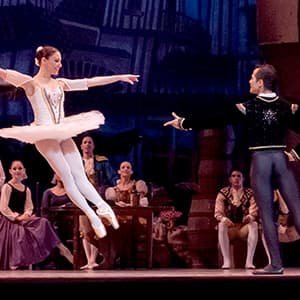

Icons Of The American Ballet Tickets
Up to 30% Off Compared to Competitors.
Location: Select Location (e.g, New York)
Events Nearby
We're Sorry. There are currently no events near you.
About Icons of the American Ballet
Currently, the American Ballet scene is vibrant and dynamic, with numerous live events that celebrate this art form. Major ballet companies are staging classic productions alongside contemporary works, making ballet accessible to wider audiences. For example, the New York City Ballet regularly features Balanchine’s iconic ballets, while the American Ballet Theatre showcases a mix of classical pieces like 'Swan Lake' and innovative contemporary works by choreographers such as Christopher Wheeldon and Alexei Ratmansky. In recent years, there has been a significant push towards inclusivity, with performances that highlight diverse voices and stories. Major events, such as the annual 'Gala of International Ballet Stars,' bring together top dancers from around the world, creating a platform for collaboration and creativity. Additionally, initiatives like the 'Ballet Across America' tour highlight regional ballet companies, allowing them to perform in various cities and engage with local communities. The COVID-19 pandemic significantly impacted live performances, leading many companies to adapt with virtual offerings and outdoor performances. As the world reopens, ballet companies are excited to return to indoor theatres, with robust seasons planned that promise to captivate audiences. The current landscape is marked by a resurgence of interest in live performance, with a focus on innovative storytelling, technology integration, and community engagement. Overall, the icons of American ballet continue to shape the future of theatre, ensuring that this timeless art form remains relevant and cherished.
Icons of the American Ballet History
The American Ballet has a rich and storied history that traces its roots back to the early 20th century, when ballet began to gain prominence in the United States. Initially influenced by European traditions, American ballet evolved through the contributions of various key figures. One of the earliest icons was George Balanchine, who co-founded the New York City Ballet in 1948 and introduced a new style that emphasized athleticism and musicality. His innovative choreography and the establishment of the School of American Ballet helped to cultivate a generation of talented dancers. Alongside Balanchine, other notable figures such as Martha Graham and Jerome Robbins further shaped the landscape of American dance, each bringing their unique styles and narratives to the forefront. The rise of American ballet continued through the latter half of the century, with the emergence of companies like the American Ballet Theatre and the Joffrey Ballet, which showcased a diverse repertoire and fostered collaboration with contemporary artists. As ballet flourished, so did the presence of legendary dancers like Misty Copeland, who broke barriers and became a symbol of diversity and inclusion within the art form. Today, their legacy continues to inspire new generations of dancers and audiences alike, solidifying the importance of ballet in American theatre.
